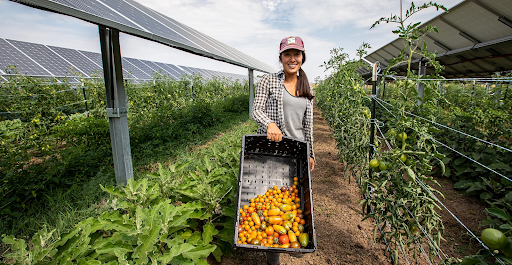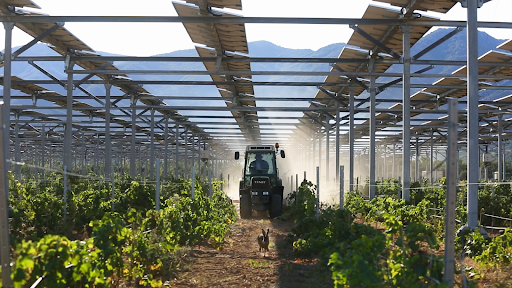
Solar farms and agriculture farms have very similar land requirements. The terrain should be stable, relatively flat, very sunny, and offer little to no obstructions. But there’s only so much of this land available, and most of it is already used for agricultural purposes.
It’s simply not feasible to sacrifice our agricultural land in favor of solar installations because we need it for essential crop production. But at the same time, we have to start sourcing our energy in more sustainable ways.
So this begs the question; how can we introduce more solar installations without diminishing our food supply?
Could the answer lie in agrivoltaics?
This extremely interesting farming practice refers to the use of solar panels and crop farming on the same piece of land. The solar panels harvest energy and provide protection for the crops that thrive in the partial shade that is created.
This innovative farming method has so far yielded very promising results, and it’s starting to catch on in the USA.
Let’s find out what it’s all about.
What Is Agrivoltaics, Exactly?
Agrivoltaics (AKA agro photovoltaics or solar sharing) is an exciting advancement in agriculture and refers to the combination of solar energy installation and farming on the same piece of land. While the concept is currently making waves across modern farming communities, it’s certainly not new.
The idea of agrivoltaics was first introduced in 1981 by Adolf Goetzberger and Armin Zastrow, who recognized that the competing need between farmers and solar installers for suitable land would only grow.
The earliest examples of this type of setup were first seen in Japan in 2004. What better place to try out agrivoltaics than in a country where space – especially suitable flat farmland – is at a serious premium?
The idea caught on, and this practice has gradually expanded across the country. Today, there are over 1,990 small-scale agrivoltaic farms spread across 47 of Japan’s 48 prefectures.
Since its inception in Japan, the practice has spread further afield. There are many exciting agrivoltaics projects occurring across Europe – notably in Germany, Spain, Italy, The Netherlands, and France.
The USA is no stranger to solar arrays, but agrivoltaics is a relatively new concept and has only started gaining attention and popularity in the past couple of years.
The Different Types of Agrivoltaics
Overall, there are three main types of agrivoltaic setups that can be seen on modern farms:
- Lines of solar arrays with space in between for crops
- Solar arrays positioned above crops on stilts
- Greenhouse solar arrays
Lined Solar Arrays
The lined arrays are positioned so that there is plenty of room to grow crops that enjoy or tolerate partial shading. For example, lettuce, broccoli, cabbage, cauliflower, peas, and potatoes are some of the crops that are suitable for partially shaded farmland.
Stilted Solar Arrays
The stilted solar arrays still provide partial shade but also provide a way for farm machinery to pass underneath easily. This opens up interesting possibilities for solar arrays to be combined with the farming of large-scale cereal crops.
Greenhouse Solar Arrays
Finally, greenhouse solar arrays use semi-transparent or bifacial modules that allow some light to pass through. This setup is particularly beneficial for crops that require temperature control and humidity.
What Are the Benefits of Agrivoltaics?
The biggest and most obvious benefit of agrivoltaics is its ability to provide a dual use for farmland. Farmers do not have to decide between growing food or producing energy because they can do both.
However, there are some other surprising and excellent benefits that also come with agrivoltaics:
- Reduced water requirements: The shade created by the solar panels keeps the ground cooler and reduces the evaporation rate of existing ground moisture. Crops stay hydrated for longer, which reduces the number of times they must be watered.
- Better yields: In a world where temperatures are rising, crop heat stress and the resulting failure is a real problem. Again, the shade from the solar panels works to reduce heat stress and UV damage resulting in a better, healthier yield.
- Increased biodiversity: The solar panels provide many shelter and habitat opportunities for wildlife to thrive. Rather than an open, somewhat barren field, the panels become a suitable place for birds, pollinators, and other animals to exist safely and contribute in a beneficial way to the ecosystem.
- Reduced soil erosion: Because of the cooler micro-climate created by the panels, the soil becomes less dry and less prone to erosion. This also has the knock-on benefit of preventing water run-off during rainy periods.
It’s not just the land and nature that benefits from agrivoltaics either. Farmers and rural communities can enjoy increased economic opportunities by leasing their land to solar developers. Not only do they get to profit from the electricity their land produces, but they also benefit from sturdier and healthier crop yields that require less water and less maintenance.
Why Aren’t Agrivoltaics Used Everywhere?
With so many benefits that come with the installation of an agrivoltaic system, this begs the question; why isn’t everyone doing it?
Well, the answer is straightforward. It comes down to cost and efficiency. While the first large solar farm in the US appeared in 1982, most of the largest solar farms didn’t establish themselves until around 2010 and beyond.
This is because the cost of installing the solar arrays was too high, and the efficiency of them was too low. According to EnergySage, in 1992, the efficiency of a solar panel was just over 15%. In 2020, this had risen to 47.1%. Additionally, the cost of a solar installation in 2009 was $8.50 per watt. Today, it can be as low as $2.77 per watt if purchased in large volumes, such as a utility scale project.
These differences are massive, and it is only within the past ten years that solar has become a truly affordable and efficient enough system to be effectively used in this manner.
And, of course, people can be slow to adapt to change. Naturally, farmers don’t want to invest the time, effort, and money into changing their entire farming setup unless they have bulletproof evidence that it will work – and be profitable.
Right now, there are many projects going on globally that are testing the viability of agrivoltaics in large-scale farming practices, and the more positive results we see from these, the faster farmers will be to adopt it themselves.
As more and more farms make the switch and adopt agrivoltaics, a snowball effect should occur, and the uptake of agrivoltaics will rapidly increase.
Some Examples of Agrivoltaics in Action
Right now, France is spearheading some interesting advancements in agrivoltaics. As Europe’s largest producer of agricultural goods, this key industry is in trouble thanks to the rising instances of prolonged drought and irregular weather patterns caused by climate change.
This puts their most important crop – the grapevine – in a very vulnerable position. In recent years, very late and unexpected frosts caused the budding vines to be destroyed quickly. Farmers were frantically lighting thousands of fires and candles to warm up the air around the vines in a desperate bid to save them.
At the other end of the scale, the country suffers from extended drought. In 2022 one of France’s important rivers – the Loire dried up almost completely.
Vines in Vaucluse

Down in the Vaucluse region of France, Sun’Agri installed a viticulture agrivoltaic system over a crop of black grenache grape. The 280 panels were installed at a height of 4.2m and utilized AI to determine the optimum tilt of the panels at any given time to maximize sunlight.
The panels not only protected the vines from too much sun exposure, but they also provided protection from frost, hail, and harsh rain.
This setup had a great outcome and resulted in the grapes requiring 12-34% less water and a better, improved aromatic quality and acidity of the grape.
Arables in Amance
Last year, French solar developer TSE commissioned a project involving three hectares of land where 5,500, 5m high stilted arrays would be mounted and combined with the cultivation of rye, barley, soya wheat, and rapeseed.
This project has the express purpose of discovering the viability of combining cereal crops with agrivoltaics and whether it’s suitable for large-scale farming practices.
The setup utilizes SCADA (Supervisory Control and Data Acquisition), which automatically determines the orientation of the solar arrays in accordance with the climate and weather conditions.
While the true results of this new venture remain to be seen, things look promising, with up to a 25% better yield produced from the first crop of soya beans. TSE anticipates further success and plans to expand the experiment over five hectares.
What About the USA?
Agrivoltaics is a much newer concept in the USA than it is in Europe, but it’s starting to catch on. And with the introduction of the Bipartisan Agrivoltaics Research and Demonstration Act of 2023, we should start to see more projects cropping up.
Solar grazing (where grazing livestock and solar panels share the same space) is one such agrivoltaics project that is becoming commonplace in Massachusetts and New York. Solar developers are now turning their attention to Maine and, with several projects underway, are transforming its pastures into solar grazing spaces.
Also, in Maine, the USA’s largest agrivoltaics pilot scheme is currently underway. Over 10,000 solar panels cover 12 acres of blueberry crops in a bid to see how effective this setup can be.
Closer to home is Jack’s Solar Garden. It’s the largest commercially active research site for agrivoltaics in the USA, with 3,200 solar panels producing enough power for 300 homes.
The Bipartisan Agrivoltaics Research and Demonstration Act of 2023
While it’s essential that the US moves toward using a greener, more sustainable energy source, it’s also not practical nor plausible to give up its vast swathes of vital food-producing farmland in favor of solar installations. And up until recently, not much has been done to address this issue.
Fortunately, positive action has now been taken, and some surprising and interesting solutions are starting to be promoted and practiced.
In May 2023, the bipartisan Agrivoltaics Research and Demonstration Act of 2023 was introduced by Martin Heinrich and Mike Braun. This act directs the U.S. Department of Agriculture (USDA) to conduct a study in order to review current research into agrivoltaics in the US and identify any existing research gaps related to agrivoltaic systems.
Additionally, the act authorizes $75 million to expand and introduce agrivoltaic systems and also aims to establish a research and demonstration network via the USDA Agricultural Research Service (ARS).
Essentially, this act will determine how agrivoltaics can make a positive impact on the environment, benefit rural communities, and increase agricultural productivity and profitability.
This is a big step for the US. Other parts of the world, such as Japan and Europe, have realized the benefits of this farming practice and are already embracing it. It’s now time for the US to get on board and follow suit.
The Future of Agrivoltaics
The future is indeed bright for this innovative farming practice. Agrivoltaics is set to soar in popularity and use. In fact, a 2022 report published by Presedence Research predicts the agrivoltaics market will reach up to 8.9 billion in 2030. That’s a huge jump from the current market value of $3.17 billion.
Additionally, the recent explosion in AI-powered advancements means that this technology can be harnessed for precision control of solar arrays bringing even more efficiency as well as helping maximize crop yields and energy harvesting.
As resources become scarcer, the population soars, and our climate nudges the temperature ever upwards, agrivoltaics could be a truly viable – and sustainable – solution that will revolutionize the way we produce food and energy.
Call or email our team today
(719) 470-0254
Frequently Asked Questions
What Crops Work With Agrivoltaics?
Crops with a good shade tolerance are the best candidates for agrivoltaics. Lettuce, broccoli, cabbage, cauliflower, peas, tomatoes, blueberries, and grapes are all good examples of what can be grown. Additionally, agrivoltaics are great for root vegetables such as potatoes, carrots, and beets.
What Are the Problems With Agrivoltaics?
The main disadvantage of agrivoltaics is the high upfront cost of the installation, which has been a barrier for many farmers who would otherwise make the transition. However, thanks to the many government tax credits and other incentives on offer, solar installations are now much more affordable.
Why Would Farmers Choose Agrivoltaics?
Agrivoltaics offers a way for farmers to maximize profit from their land. This is achieved by selling the power they generate and selling the crops they produce. This system also significantly reduces power bills and running costs of the farm.
Do Solar Farms Damage the Soil?
Solar farms do not damage the soil. Instead, they are actually very beneficial. The shade created by the panels creates a cooler microclimate which reduces water evaporation, water run-off, and soil erosion. It also encourages more biodiversity, which contributes to the health of the soil.
Does Agrivoltaics Work?
Current agrivoltaic farms have shown that this farming method produces better and healthier yields along with improved soil quality and moisture retention. In short, agrivoltaics works very well, but it isn’t suitable for crops that dislike the shade.
